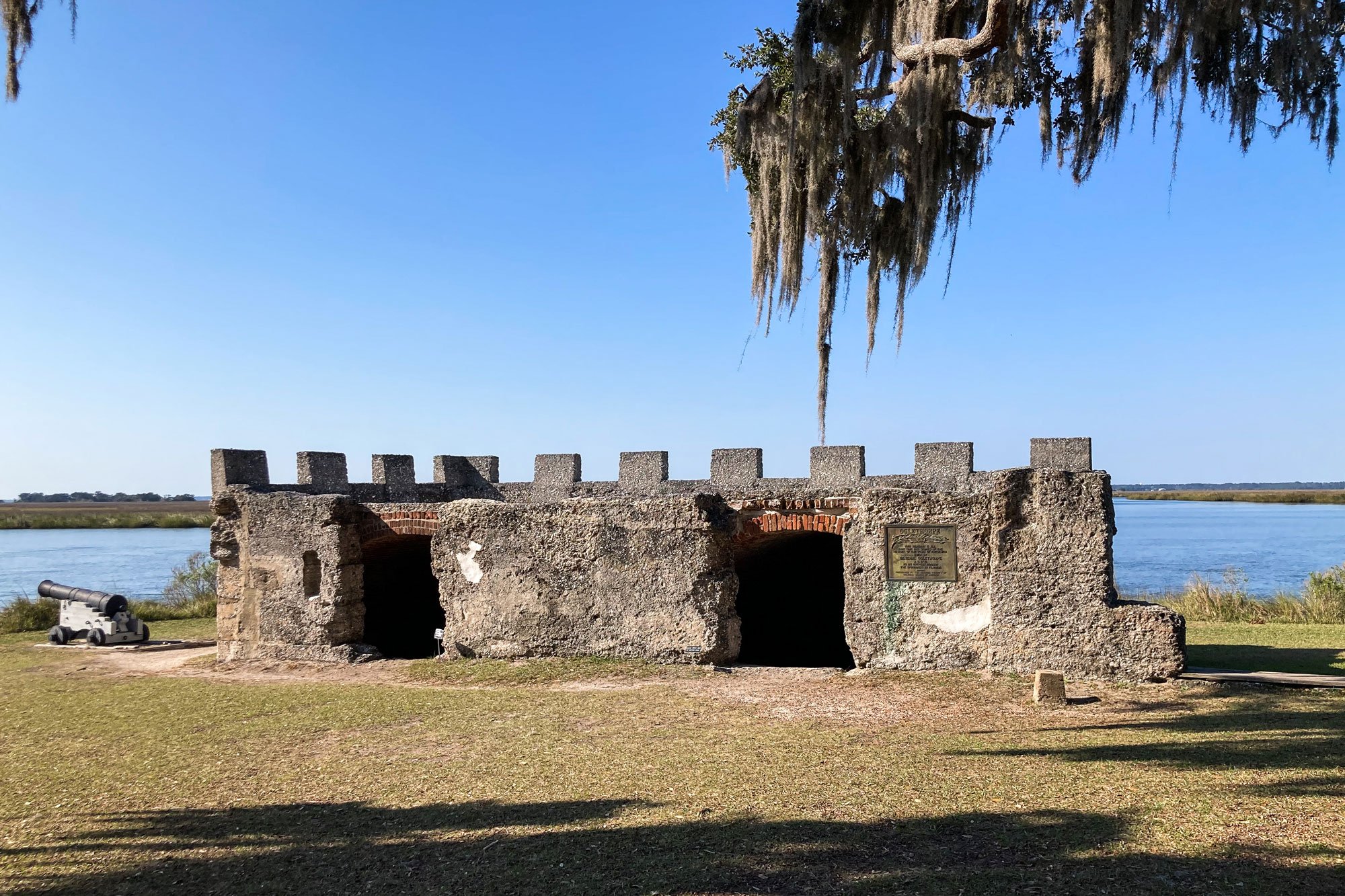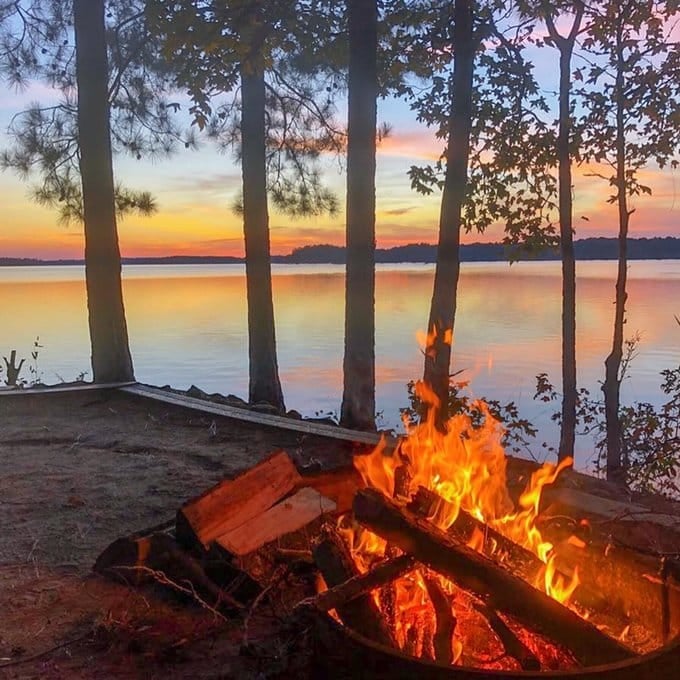From Florida to the Carolinas, these sites mix history with outdoor activities
Our favorite fort was perhaps the least known, and one of the last that we visited. Part of the appeal was arriving by water on a warm December afternoon aboard a nearly empty National Park Service (NPS) ferry. As the boat approached Rattlesnake Island, we got a closer look at the small but impressive Matanzas Tower. This curiously shaped masonry fort was built by the Spanish in the early 1740s as a watchtower. Its location—just inside the mouth of the tidal Matanzas River on the coast of Northern Florida—was chosen to protect the nearby colonial city of St. Augustine.
Today the watchtower rises above the Intracoastal Waterway as the centerpiece of Fort Matanzas National Monument. This fun NPS unit is entirely free, including the hourly ferries to the fort. The park’s 228 acres also include two short nature trails winding through coastal live oak forest and a section of beach on the Atlantic Ocean.
After a brief historical presentation by the ranger, the open-air ferry docked, and our small group pressed toward the wall like friendly invaders. The best part of visiting Fort Matanzas is that you can explore every inch of this restored and preserved structure using stairs and ladders. The fort was built using blocks of coquina, a sedimentary stone of naturally cemented shell fragments found along the coast. The first level is a 50-foot square wall, with a sentry box and gun deck. The park service has mounted replica cannons to demonstrate how the inlet was guarded. Such defensive action happened only once, in 1742, when two British long boats tested the inlet but turned back after the recently armed fort opened fire.
Rising above the gun deck is the two-story watchtower, which houses re-creations of the soldiers’ and officers’ quarters. After touring the sparse furnishings, my wife and I climbed the ladder to the observation deck. The flag of New Spain, with red branches crossed over a white background, flapped overhead. Below, we spotted a sea turtle swimming in a clear-water cove. We chatted with the friendly ranger about this historic site and others we’d visited.
All along the Southern coast there are many forts preserved as national and state park units. A visit to these historic sites can often be combined with onsite or nearby recreational opportunities like walking paths, hiking and biking trails, paddling routes, and camping. At first, my wife and I stumbled across the forts when we began exploring the region, but eventually the goal was to see them all. Visiting these forts reveals vibrant scenery as well as some of the violent history of this coastline, offering opportunities for relaxation and thoughtful reflection. Here are some of our favorites to explore.
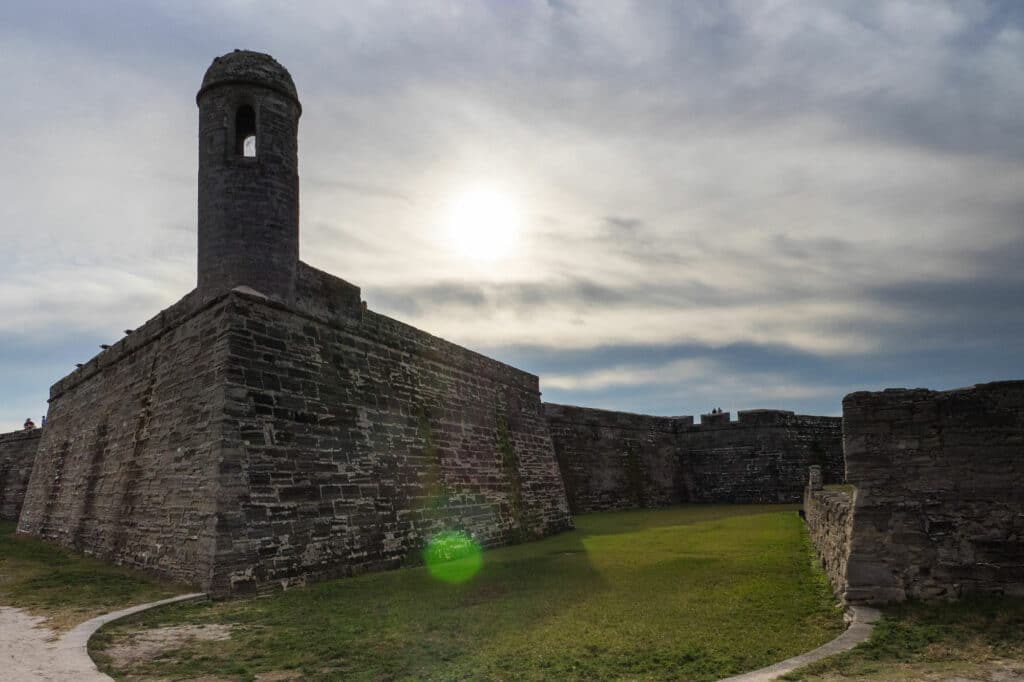
Castillo de San Marcos National Monument
St. Augustine, Florida
Perhaps the most impressive fort along this coastal stretch is Castillo de San Marcos, which was established as the northernmost outpost of Spain’s New World empire. This picturesque fort—like its southern watchtower Matanzas—was built with blocks of coquina. But Castillo de San Marcos is much bigger, about 500 feet tip to tip, a classic star-shaped fort with a square core and four diamond-shaped bastions at each corner. The city the fort was built to protect, St. Augustine, was founded in 1565, making it the oldest continuously inhabited European settlement in the U.S. After 20 years of construction, the Castillo was completed in 1695, making it the oldest masonry fort in the U.S.
Today, a visit to the NPS-preserved Castillo de San Marcos fort is mostly about wandering the surrounding 20-acre grounds. You can sit on the stone walls and admire the city, the riverfront, and the art deco Bridge of Lions. The busy city of St. Augustine is very much on the Florida tourist trail, as visitors crowd the historic downtown and admire the colonial architecture. Popular spots include the Lightner Museum, the St. Augustine Distillery, and Dog Rose Brewing Co.
For a more outdoorsy stop nearby, head about 10 miles north to the Guana Tolomato Matanzas National Estuarine Research Reserve. The big-name fits for what is essentially a 76,000-acre coastal nature reserve. An entry fee offers access to walking trails, paddling routes, a beach, and an educational visitor center.
Fort Clinch State Park
Fernandina Beach, Florida
Within sight of the Georgia state line, this 1,400-acre park is a great place for a coastal camping trip. The 3.5-mile scenic drive through the park is famous for its tunnel-like canopy of salt-pruned oak forest with hanging Spanish moss.
At the tip of Amelia Island, you can explore the beautifully restored Fort Clinch. This classic red-brick structure was built as part of the Third System, a U.S. coastal defense network established between the War of 1812 and the Civil War. Other highlights include short walking paths and a six-mile multi-use trail through the woods that’s used by hikers and mountain bikers.
On the Atlantic side, beachgoers play in the waves and search the sand for fossilized shark teeth. On the Cumberland Sound side, kayakers often explore the protected inlet. The nearby town of Fernandina Beach has a small historic old town to explore and plenty of restaurants and bars, including First Love Brew Pub, a favorite stop for craft beer and creative food.
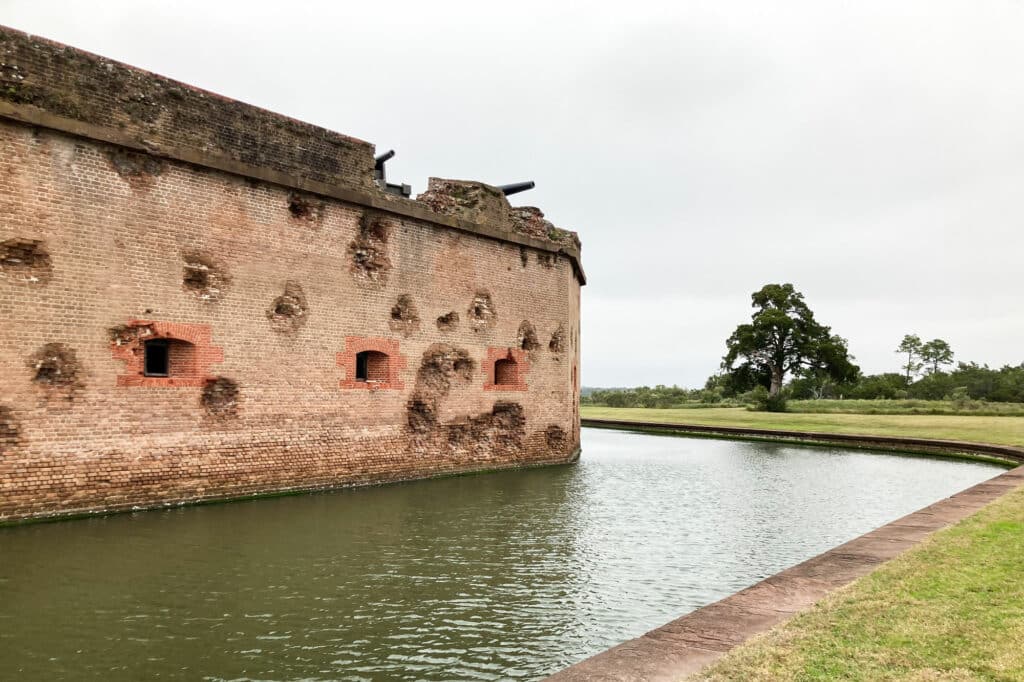
Fort Pulaski National Monument
Savannah, Georgia
This stop on Cockspur Island outside Savannah will appeal to Civil War buffs. Many may recall the dramatic story without realizing this bombarded fort remains mostly intact. Through NPS restoration and interpretation, the fort is one of the most interesting to explore today.
Early in the war, the Union Army tested a new type of weapon, the rifled cannon, against the Confederate-occupied fort. Resembling the swirling pattern that surrounds the swaggering James Bond in a 007 film opening, rifling involves machining helical grooves inside the cannon barrel. This imparts spin on the projectile, which improves distance and accuracy. On the morning of April 10, 1862, Union forces began bombarding Fort Pulaski from another island about a mile away. By the second day, the walls were breached in three places and the fort surrendered. This outcome rendered obsolete all the brick fortifications of the Third System. As a result, very few saw combat and most remained intact and became historic sites.
The highlight here is touring both the interior and exterior of Fort Pulaski, with its stabilized outer walls still bearing the cratered scars of cannon fire. Visitors will also find a variety of outdoor activities throughout this 5,623-acre NPS unit. Several short hiking trails, about a mile or two in length, explore the historic grounds and surrounding woodlands. There’s a boat ramp from which paddlers can explore the tidal channels, and along the north shore of Tybee Island, you’ll find the six-mile McQueens Island multiuse path. This crushed gravel trail, primarily used for cycling and running, follows the old railroad line from Savannah to Tybee Island.
Fort Sumter and Fort Moultrie National Historic Park
Charleston, South Carolina
Fort Sumter probably has the greatest name recognition of all the sites on this list. On April 12, 1861, Confederate forces fired the opening shots of the Civil War against the Union-occupied fort. During the war, the impressive three-story fort—with brick walls five feet thick and fifty feet high—was reduced to rubble. What remains today is the restored first level and the inner battery, where artillery was once mounted and which today houses a museum.
Located on a small island in the middle of scenic Charleston Harbor, Fort Sumter can only be visited by NPS concessionaire boats. These ferries depart from either the NPS visitor education center at Liberty Square in downtown Charleston or from the concessionaire dock at Patriots Point (next to the Naval and Maritime Museum, with retired aircraft carrier, destroyer, and submarine) in the nearby town of Mount Pleasant. The downtown choice may be preferred by history and architecture enthusiasts, who can tack on a walking tour of busy colonial Charleston. The Mount Pleasant option allows a visit to nearby Shem Creek Park, where you can walk about a mile of boardwalks, visit a waterfront bar and grill, or rent a kayak and explore the tidal inlets. Mount Pleasant also has a historic district of colonial homes to wander through.
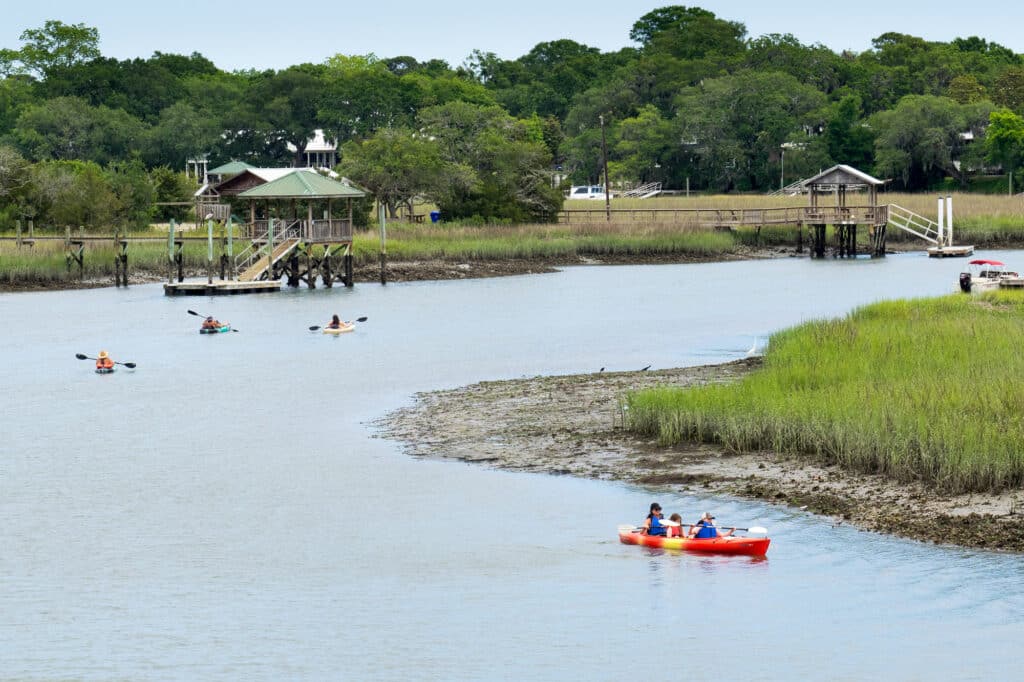
Consider doubling up on history by stopping by, or substituting, the other half of this NPS unit, Fort Moultrie, on nearby Sullivan’s Island. Admission to the lesser-known Moultrie costs less and can be reached by vehicle. The fort remains fully intact and originally dates from the time of the American Revolution, showcasing nearly 200 years of military advances. There’s also a small World War II command post to explore, which was built with steel inside the older brick walls. Standing atop those defensive walls offers one of the best views of Fort Sumter, across the water. Afterward, you can explore the grounds and oceanfront beach.
More Forts to Explore
There are many more historic forts along the South’s coast that are worth a stop, including the mysterious Fort Raleigh National Historic Site on Roanoke Island, NC. One of the most remote forts is a small, earthen outpost named Battery Warren on the swampy Santee River inside Francis Marion National Forest, in the South Carolina Low Country. And one of the most historic is Fort Frederica National Monument, on St. Simons Island, site of the first English colony in Georgia, which, beyond the few stone walls of the remaining foundation, features scenic wooded grounds next to a tidal waterway.
Cover photo: Fort Frederica in Georgia. Photo by MIke Bezemek
